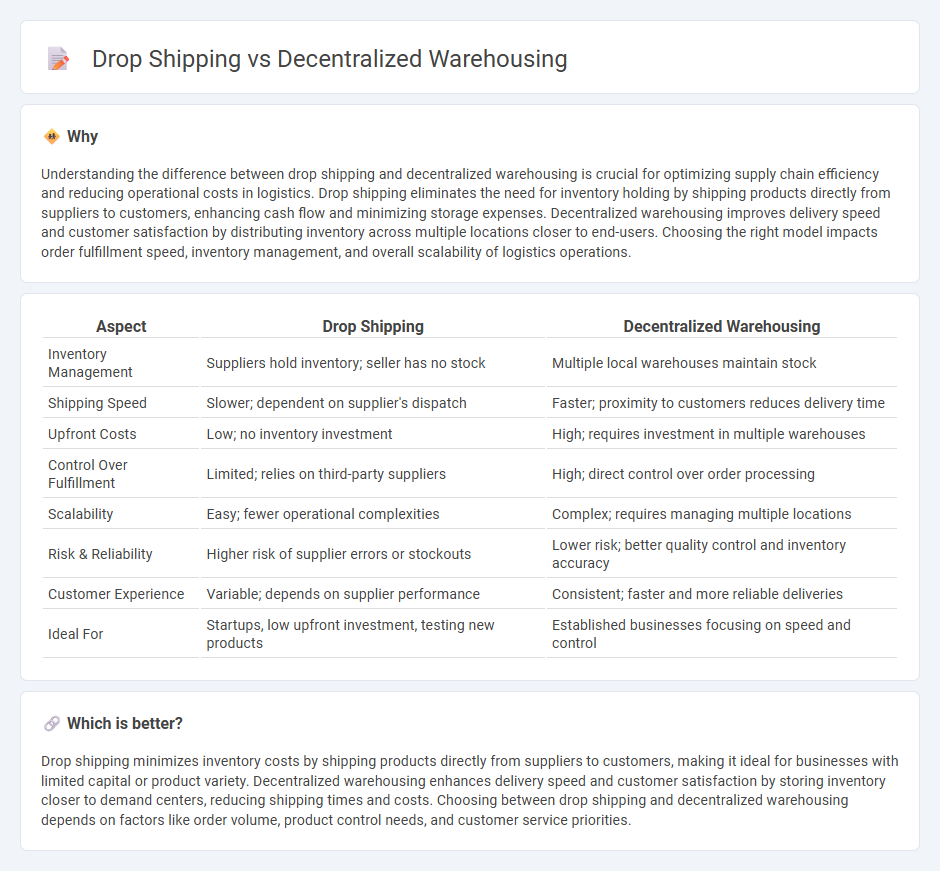
Dropshipping eliminates the need for inventory management by directly shipping products from suppliers to customers, reducing upfront costs and inventory risks. Decentralized warehousing involves storing products across multiple strategically located facilities, enabling faster delivery times and increased supply chain resilience. Explore the benefits and challenges of each model to determine the best fit for your logistics strategy.
Why it is important
Understanding the difference between drop shipping and decentralized warehousing is crucial for optimizing supply chain efficiency and reducing operational costs in logistics. Drop shipping eliminates the need for inventory holding by shipping products directly from suppliers to customers, enhancing cash flow and minimizing storage expenses. Decentralized warehousing improves delivery speed and customer satisfaction by distributing inventory across multiple locations closer to end-users. Choosing the right model impacts order fulfillment speed, inventory management, and overall scalability of logistics operations.
Comparison Table
| Aspect | Drop Shipping | Decentralized Warehousing |
|---|---|---|
| Inventory Management | Suppliers hold inventory; seller has no stock | Multiple local warehouses maintain stock |
| Shipping Speed | Slower; dependent on supplier's dispatch | Faster; proximity to customers reduces delivery time |
| Upfront Costs | Low; no inventory investment | High; requires investment in multiple warehouses |
| Control Over Fulfillment | Limited; relies on third-party suppliers | High; direct control over order processing |
| Scalability | Easy; fewer operational complexities | Complex; requires managing multiple locations |
| Risk & Reliability | Higher risk of supplier errors or stockouts | Lower risk; better quality control and inventory accuracy |
| Customer Experience | Variable; depends on supplier performance | Consistent; faster and more reliable deliveries |
| Ideal For | Startups, low upfront investment, testing new products | Established businesses focusing on speed and control |
Which is better?
Drop shipping minimizes inventory costs by shipping products directly from suppliers to customers, making it ideal for businesses with limited capital or product variety. Decentralized warehousing enhances delivery speed and customer satisfaction by storing inventory closer to demand centers, reducing shipping times and costs. Choosing between drop shipping and decentralized warehousing depends on factors like order volume, product control needs, and customer service priorities.
Connection
Drop shipping relies on decentralized warehousing by eliminating the need for sellers to hold inventory, instead shipping products directly from multiple distributed warehouses or suppliers. This integration enhances supply chain efficiency, reduces shipping times, and lowers storage costs by leveraging strategically located fulfillment centers. The connection between drop shipping and decentralized warehousing optimizes inventory management and enables scalable, flexible logistics operations across diverse markets.
Key Terms
Inventory Ownership
Decentralized warehousing involves businesses owning and managing inventory stored in multiple locations to reduce shipping times and improve customer satisfaction. Drop shipping eliminates inventory ownership by having suppliers directly ship products to customers, minimizing upfront costs but reducing control over stock quality and availability. Explore the advantages and challenges of these models to determine the best fit for your supply chain strategy.
Fulfillment Speed
Decentralized warehousing reduces fulfillment speed by storing inventory closer to customers, enabling faster shipping and delivery compared to centralized models. Drop shipping relies on suppliers to ship products directly, which can result in longer fulfillment times due to dependency on third-party processing and handling. Explore the advantages and drawbacks of each method to optimize your supply chain efficiency.
Distribution Network
Decentralized warehousing distributes inventory across multiple locations, reducing delivery times and enhancing supply chain resilience compared to centralized models. Drop shipping eliminates the need for inventory storage by directly fulfilling orders from suppliers, which lowers overhead but may increase shipping variability. Explore detailed insights on how these distribution strategies impact operational efficiency and customer satisfaction.
Source and External Links
Centralized vs. decentralized warehousing: Which is best for your ... - Decentralized warehousing uses multiple strategically located facilities storing inventory closer to customers, enabling faster delivery, reduced shipping costs, and adaptability during peak demand but comes with higher operating costs.
Decentralization of Warehouses in the E-commerce Age (Pros, Cons ...) - This model increases delivery flexibility, lowers transport costs, enables faster dispatch, and supports higher delivery frequency by distributing inventory near end consumers.
Centralized vs. Decentralized Warehousing: Which is Better for Your ... - Decentralized warehousing enhances delivery speed, market responsiveness, and risk mitigation by spreading inventory across regions, but requires managing higher costs, complexity, and potential stock inefficiencies.
 dowidth.com
dowidth.com